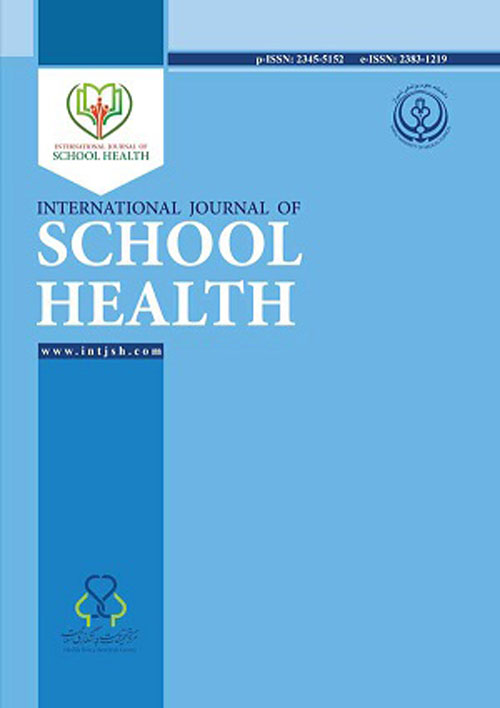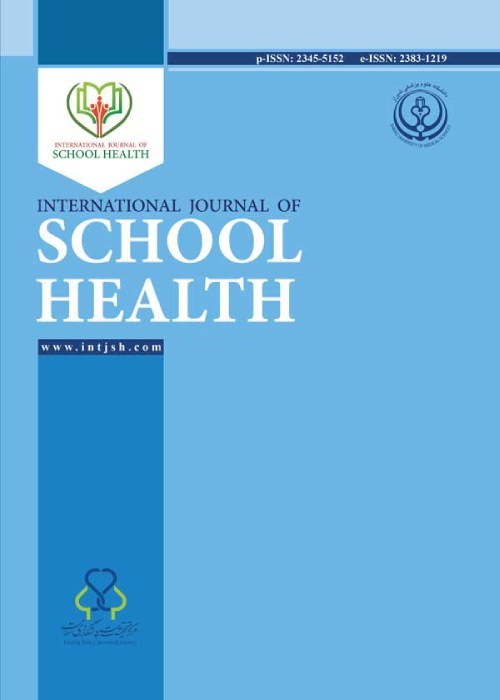فهرست مطالب

International Journal of School Health
Volume:1 Issue: 1, Spring 2014
- تاریخ انتشار: 1393/06/19
- تعداد عناوین: 7
-
-
Page 2BackgroundIran, with the second youngest population in the Eastern Mediterranean Region, faces a high demand on health and education. The Iranian youth are at risk for common behavioral problems that may affect their present and future health. The Health Promoting School Initiative is a well-known international approach that addresses these risks. The Health-Promoting School Program was launched as a national initiative in Iran in 2003..ObjectivesThis article is the result of an evaluation study that has attempted to assess the intermediate outcomes of this initiative..Materials And MethodsThe study was a before-after single community intervention with cluster sampling in which 32 clusters were randomly selected from 215 health-promoting schools in 6 socioeconomically representative provinces of Iran. The calculated sample size was 1260 students from the first grade (grade 9) of secondary school. Educational approach was a mix of active education, peer education and life skills training which targeted 6 prime messages on risk behaviors..ResultsWe observed improvement in the students’ knowledge on sound definition of health, the cause of HIV/AIDS and the route of transmission, different risks and the places with high potential to encounter a risk, consequences of smoking and violence. Attitudes of the participants towards risk and protective behaviors, with the exception of better understanding of laws, improved with little difference between male and female participants..ConclusionsThe Health Promoting School Program model in Iran can significantly improve knowledge and attitude of students regarding the prime messages that address risk behaviors. There is a need to revise the material to maximize the outcomes..Keywords: Health Promoting, School, Evaluation
-
Page 3BackgroundThe epidemic peak of obesity and overweight began in 1980. Obesity during childhood and adolescence, particularly in the second decade of life, is a strong predictor of obesity in adulthood. The significant risk factors for obesity and overweight in childhood include breastfeeding, obese parents, socioeconomic status, birth weight, physical activities and diet. Breastfeeding is one of the most important strategies for weight loss and reduction in childhood obesity..ObjectivesThe purpose of this study is to investigate the relationship between overweight, obesity, breastfeeding patterns and birth weight among first grade elementary school students in Shiraz, Iran..Patients andMethodsThis case-control study included 200 obese (case group) and 200 normal weight (control group) children. A sample size of 400 children was determined. Study participants were selected from among elementary schools in Shiraz by multistage sampling. First, schools were chosen according to a stratified random sampling method. Then, we chose all overweight or obese first grade students. For each case, we chose a control student matched in terms of age, sex, grade and elementary school. The General Information Questionnaire, Socioeconomic Questionnaire, Questionnaire of Breastfeeding during Infancy, Physical Activity Questionnaire and 24-Hour Dietary Recall Questionnaire were completed. Mothers’ height and weight were also measured. Data analysis was carried out by SPSSversion 15..ConclusionObesity and overweight in first grade elementary school students is related to breastfeeding pattern; however, this may not be an independent relationship..ResultsThere was a significant difference in breastfeeding duration between the case and control groups. No relationship was found among birth weight, overweight and obesity in the case group. Mother’s body mass index (BMI) and obesity in immediate family members showed a significant difference between case and control groups. There was no significant difference in the socioeconomic status of the two groups..Keywords: Overweight, Obesity, Breast feeding, Birth weight
-
Page 4BackgroundAdolescence is a crucial stage of life during which a person faces primary cognitive and structural changes..ObjectivesIn this study, we seek to investigate the relationship between resilience and coping styles with mental health in first grade high school students from Ardabil, Iran..Materials And MethodsWe used a multistage random sampling method to select 100 first grade high school students from Ardabil. The participants were asked to complete the Conner-Davidson Resilience Scale, the Coping style questionnaire and the 28 item General Health questionnaire. Pearson correlation and multiple regressions were performed for data analysis..ResultsThere was a significant statistical relationship between resilience and coping styles with mental health (p < 0.01). In addition, the findings demonstrated that resilience and problem-oriented coping might significantly predict the mental health of adolescents. These findings might prove that resilience could be one of the best predictors of mental health in this study''s target group of students..ConclusionsFindings of this study imply the crucial role of resilience and coping styles in mental health of adolescents. In other words, relationship between mental health and coping styles is taken into consideration due to the mediating effect of coping on perception and reaction towards environmental stress pressures. Schools play a key role in shaping the future of adolescents. In Iran, the youth constitute a significantly huge percent of our society, therefore attempts to enhance mental health in adolescents is one of the most important duties of any educational organization, particularly schools..Keywords: Resilience, Mental Health, Adolescent
-
Page 5BackgroundCreativity and academic progress are main issues of the educational system..ObjectivesFor improving student achievement and increasing creativity and innovation, various methods have been proposed..Materials And MethodsThis study enrolled 48 first year high school students. Participants were randomly assigned to experimental and control groups. After a description of the research objectives and obtaining participant consent, we used a researcher-generated questionnaire to collect data. Before any intervention we retrieved participants'' grade point averages (GPA) from the first semester in order to verify academic progress of both groups. At baselines, both groups were assessed with an Emotional Intelligence Questionnaire (Bar-On) and Abebi’s creativity test. The experimental group received a three-month training program on emotional intelligence that was conducted in 10 sessions, for an average of 30minutesper session. The control group did not receive any special training. At the end of the training program we administered the same questionnaires in both groups as a post-test. For data analysis, analysis of variance, correlation and regression analysis, and the t-test were used..ResultsThis method significantly increased students'' academic progress and creativity. The emotional intelligence factor alone predicted 32% (R2 = 0.32) of variance related to creativity and 18% (R2 = 0.18) of variance related to students'' educational progress..ConclusionsThe results of this study can be used as a method for increasing and improving student achievement and increasing creativity in high school students..Keywords: Emotional intelligence, Creativity, Academic Achievement
-
Page 6BackgroundPerfectionism is marked by several cognitive biases, including a tendency towards rumination and generalization of failures, strong attention to errors and a tendency to interpret ambiguous feedback as critical or negative..ObjectivesThis study investigates the predictive role of early maladaptive schemas in neurotic perfectionism in middle-school female students from Kangavar, Iran..Materials And MethodsThis descriptive-comparative causal study was carried out on 250 female students of a middle-school in Kangavar. Participants were selected according to multistage randomized cluster sampling. The instruments used were the New Measure of Perfectionism and the Early Maladaptive Schema Questionnaire for Children Data were analyzed at the 95% confidence level, using SPSS 18 statistical software..ResultsThe study demonstrated that perfectionist students gained significantly higher scores in six out of eleven schemas (P < 0.05). There was a significant positive relationship among early maladaptive schemas and perfectionists in the schemas of loneliness, vulnerability, mistrust and abuse, submission, and unrelenting standards. Self-sacrifice predicted neurotic perfectionism in students..ConclusionsEarly maladaptive schema may develop during the earliest years of life. It can be said that identification and diagnosis of early maladaptive schema among students will enable the provision of interventions for psychological disorders related to maladaptive schemas, including neurotic perfectionism..Keywords: Early Maladaptive Schemas, Perfectionist, Students
-
Page 7IntroductionEpidermoid cyst of the testis is a rare benign tumor. Controversies exist with regards to the management of these cysts. Whilst some surgeons have performed radical orchidectomy, others adopt a conservative approach..Case report: We have reported a case of epidermoid cyst in the left testis in a six-year-old male who presented with a painless hard mass in the upper pole of the left testis with increased serum LDH and uncertain ultrasound features, which was treated by radical orchidectomy..ConclusionsOur reported case did not have the classic epidermoid cyst imaging features and additionally had an elevated serum LDH level therefore we decided to perform an inguinal radical orchiectomy..Keywords: Cyst, Testis, LDH


